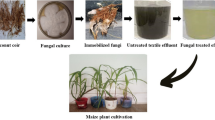Abstract
The vast untapped potential of hairy root cultures as a stable source of biologically active chemicals has focused the attention of scientific community toward its commercial exploitation. However, the major bottleneck remains its successful scale-up. Due to branching, the roots form an interlocked matrix that exhibits resistance to oxygen transfer. Thus, present work was undertaken to develop cultivation strategies like optimization of inlet gas composition (in terms of % (v/v) O2 in air), air-flow rate and addition of oxygen vectors in the medium, to curb the oxygen transfer limitations during hairy root cultivation of Azadirachta indica for in vitro azadirachtin (a biopesticide) production. It was found that increasing the oxygen fraction in the inlet air (in the range, 20–100% (v/v) O2 in air) increased the azadirachtin productivity by approximately threefold, to a maximum of 4.42 mg/L per day (at 100% (v/v) O2 in air) with respect to 1.68 mg/L per day in control (air with no oxygen supplementation). Similarly, increasing the air-flow rate (in the range, 0.3–2 vvm) also increased the azadirachtin productivity to a maximum of 1.84 mg/L per day at 0.8 vvm of air-flow rate. On the contrary, addition of oxygen vectors (in the range, 1–4% (v/v); hydrogen peroxide, toluene, Tween 80, kerosene, silicone oil, and n-hexadecane), decreased the azadirachtin productivity with respect to control (1.76 mg/L per day).




Similar content being viewed by others
References
Srivastava, S., & Srivastava, A. K. (2007). Critical Reviews in Biotechnology, 27, 29–43.
Kanokwaree, K., & Doran, P. M. (1997). Biotechnology Bioengineering, 55, 520–526.
Asplund, P. T., & Curtis, W. R. (2001). Biotechnology Progress, 17, 481–489.
Jeong, C. S., Chakrabarty, D., Hahna, E. J., Lee, H. L., & Paek, K. Y. (2006). Biochemical Engineering Journal, 27, 252–263.
Yu, S., & Doran, P. M. (1994). Biotechnology Bioengineering, 44, 880–887.
Yu, S., Mahagamasekera, M. G. P., Williams, G. R. C., Kanokwaree, K., & Doran, P. M. (1997). In P. M. Doran (Ed.), Hairy roots: culture and applications (pp. 139–150). Amsterdam: Harwood.
Weathers, P. J., Wyslouzil, B. E., Wobbe, K. K., Kim, Y. J., & Yigit, E. (1999). In Vitro Cellular and Developmental Biology- Plant, 35, 286–289.
Shiao, T., & Doran, P. M. (2000). Journal of Biotechnology, 83, 199–210.
Leathers, R. R., Smith, M. A. L., & Christie, A. J. (1995). In J. A. Christie, T. Kozai, & M. L. Smith (Eds.), Automation and environmental control in plant tissue culture (pp. 187–214). Dordrecht: Kluwer.
Williams, G. R. C., & Doran, P. M. (1995). Australian Biotechnology, 5, 92–94.
Tescione, L., Ramakrishnan, D., & Curtis, W. R. (1997). Enzyme and Microbial Technology, 20, 207–213.
Han, J., & Zhong, J. J. (2003). Enzyme and Microbial Technology, 32, 498–503.
Schlatmann, J. E., Nuutilam, A. M., van Gulik, W. M., ten Hoopen, H. G. J., Verpoorte, R., & Heijhen, J. J. (1993). Biotechnology Bioengineering, 41, 253–262.
Liu, Y. S., & Wu, J. Y. (2006). Journal of Applied Microbiology, 101, 1033–1038.
Murashige, T., & Skoog, F. (1962). Physiology Plant, 15, 473–497.
Gamborg, O. L., Miller, R. A., & Ojima, K. (1968). Experimental Cell Research, 50, 151–158.
Prakash, G., Emmannuel, C. J. S. K., & Srivastava, A. K. (2005). Biotechnology and Bioprocess Engineering, 10, 198–204.
Dubois, M., Gilf, K. A., Hamilton, J. K., Roberts, P. A., & Smith, F. (1956). Analytical Chemistry, 28, 350–356.
Brunner, I., Brodbeck, S., & Walthert, L. (2002). Forest Ecology and Management, 165, 75–84.
Martin, Y., & Vermette, P. (2005). Biomaterials, 26, 7481–7503.
Pinheiro, R., Belo, I., & Mota, M. (2000). Enzyme and Microbial Technology, 26, 756–762.
Kim, Y., Wyslouzil, B., & Weathers, P. (2001). Plant Cell Report, 20, 451–455.
Souret, F. F., Kim, Y., Wyslouzil, B. E., Wobbe, K. K., & Weathers, P. J. (2003). Biotechnology Bioengineering, 83, 653–667.
Curtis, W. R. (2005). Plant Cell Tissue and Organ Culture, 81, 255–264.
Liu, C., Wang, Y., Guo, C., Ouyang, F., Ye, H., & Li, G. (1998). Bioprocess Engineering Journal, 19, 389–392.
Lee, B. S., & Kim, E. K. (2004). Enzyme and Microbial Technology, 35, 639–647.
Newman, L. A., & Reynolds, C. M. (2005). Trends in Biotechnology, 23, 6–8.
Dumont, E., Andrès, Y., & Le Cloirec, P. (2006). Biochemical Engineering Journal, 30, 245–252.
Author information
Authors and Affiliations
Corresponding author
Rights and permissions
About this article
Cite this article
Srivastava, S., Srivastava, A.K. Strategies to Overcome Oxygen Transfer Limitations During Hairy Root Cultivation of Azadiracta indica for Enhanced Azadirachtin Production. Appl Biochem Biotechnol 167, 1818–1830 (2012). https://doi.org/10.1007/s12010-011-9531-5
Received:
Accepted:
Published:
Issue Date:
DOI: https://doi.org/10.1007/s12010-011-9531-5




